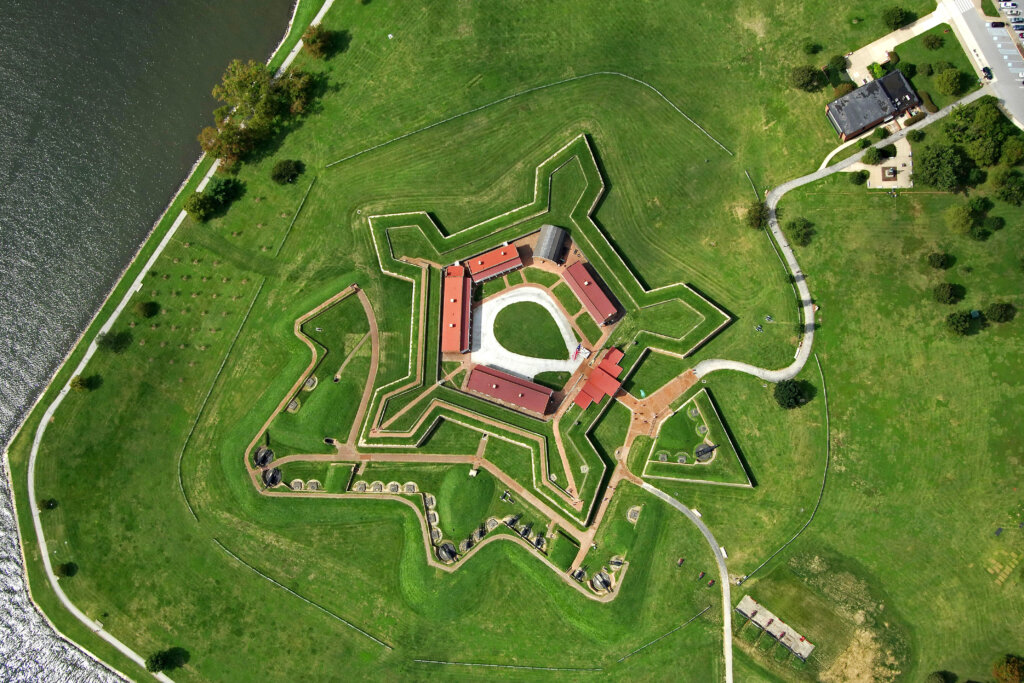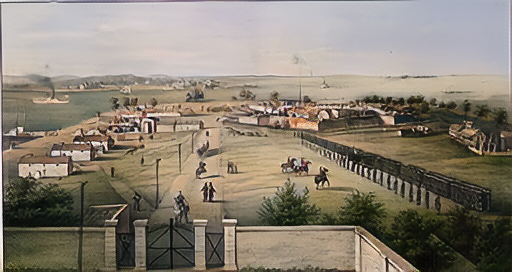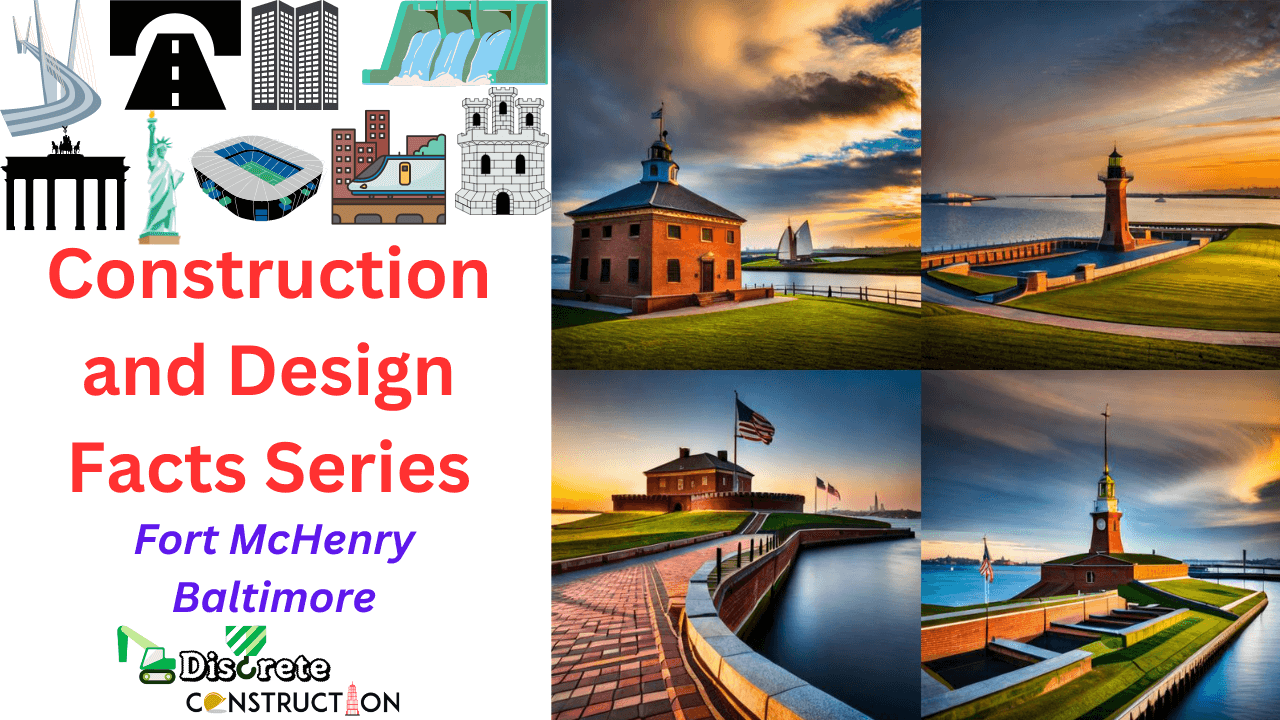The dawn of the 19th century witnessed an era of monumental changes for the nascent United States. It was an epoch of new beginnings, of territorial consolidation, and of defending those territories with unwavering resolve. Perhaps no other edifice encapsulates this spirit of American perseverance as vividly as the Fort McHenry in Baltimore. This iconic star-shaped fort, nestled in the bosom of the Patapsco River, serves as a poignant emblem of the nation’s relentless pursuit of freedom and sovereignty.
In the annals of American history, Fort McHenry stands as a stalwart reminder of the resilience and strategic acumen demonstrated during the War of 1812. It was here, in the Battle of Baltimore, where American forces steadfastly withstood a 25-hour bombardment by the British Navy. A testament to the fort’s sturdy construction and strategic design, this unforgettable engagement inspired Francis Scott Key to pen the poem that would eventually become the national anthem, ‘The Star-Spangled Banner.’
Yet, Fort McHenry isn’t just an embodiment of American resilience or a catalyst for a symbol of national identity. Its fascinating architecture, imbued with technical and practical insights from early 19th century, remains a topic of profound interest for architects, civil engineers, historians, and enthusiasts alike. Its construction involved innovative techniques, strategic military engineering, and an artful blend of form and function that continues to inspire awe and admiration even today.

In this comprehensive examination, we delve into the captivating intricacies of Fort McHenry’s design and construction, encompassing its journey from conception to final manifestation. We explore the principles that governed its formation, understand the challenges it weathered, and appreciate the meticulous craftsmanship that it reflects. Through a series of 100 intriguing facts, we aim to offer an enlightening perspective that intertwines the fort’s historical significance with its architectural prowess.
This discourse delves deep into the architectural nuances that define Fort McHenry. It isn’t merely an exploration of the physical structure; it’s an intimate journey through the historical circumstances that led to the fort’s construction, the strategic decisions influencing its design, and the technical expertise mobilized to bring this formidable fortress to life.
The narrative explores various facets of Fort McHenry, from its robust foundation to the formidable superstructure. We scrutinize the materials employed, the methods used to fortify its defenses, and the painstaking process of preserving this iconic edifice for future generations. The tale of Fort McHenry is a rich blend of engineering ingenuity and architectural vision that offers invaluable insights into early American fort construction.

Moreover, we delve into the technical data and specifications that determined the fort’s robustness, the nature of the loads it was designed to bear, the principles underlying its layout, and the codes adhered to during its construction. The discourse further sheds light on the fort’s long-standing endurance and offers a holistic economic analysis of the structure.
Our journey to unravel the construction and design facts of Fort McHenry is an expedition into an important chapter of American history. The fort’s architectural elements do not merely serve a functional purpose; they embody the unyielding spirit of a young nation determined to defend its sovereignty. As you navigate through these 100 facts, you’ll discover a narrative that is as much about human determination and courage as it is about bricks, mortar, and architectural design.
We invite you to embark on this enlightening exploration of Fort McHenry. Whether you’re a historian seeking to better understand the past, an architect or engineer intrigued by historical structures, or an inquisitive mind yearning to unearth the narratives ingrained in America’s built environment, this exploration promises to enrich your understanding of this iconic fort. As we uncover these fascinating facts, we trust you’ll gain a deeper appreciation for the intricate tapestry of history, architecture, and human resolve that constitutes the fort’s enduring legacy.
The story of Fort McHenry is more than just an architectural case study; it’s a testament to the remarkable interplay of strategic military planning, civil engineering, and resilient construction. As we delve into the depth of its architectural grandeur, we rediscover an emblem of strength, ingenuity, and the spirit of a nation coming into its own. This exploration is a tribute to that spirit and a celebration of the craftsmanship that has ensured Fort McHenry’s status as a symbol of American resilience for over two centuries.
Top-100 Facts of Fort McHenry Baltimore
- Fort McHenry was designed as a star fort or bastion fort, a type of fortification originating in the 15th century in Italy.
- It was named after James McHenry, a Scots-Irish immigrant who was a signer of the United States Constitution.
- The fort was constructed between 1798 and 1803 under the supervision of Major George Armistead.
- It was designed by French-born engineer Jean Foncin.
- Fort McHenry covers an area of approximately 43 acres.
- The fort was built with bricks and mortar, common construction materials of that time.
- It features a dry moat that was intended to deter attackers and protect the main structures.
- The fort is most famous for successfully defending Baltimore Harbor from the British navy in the War of 1812.
- The successful defense of the fort in the Battle of Baltimore served as the inspiration for the American national anthem, “The Star-Spangled Banner.”
- The fort’s design includes five bastions, with each capable of supporting a significant amount of artillery.
- The soil composition at the fort includes layers of silt, clay, and organic matter, typical of the Chesapeake Bay area.
- The fortification underwent a significant upgrade between 1861 and 1869 to accommodate newer, more powerful artillery.
- The “Star Fort” design meant that there were no blind spots for defenders, and all sides could be covered by cannon fire.
- The walls of the fort are 3-4 feet thick on average, designed to withstand cannon fire.
- Fort McHenry was also used as a prison during the Civil War, housing Confederate soldiers and sympathizers.
- The fort was made a national park in 1925.
- The foundation and superstructure of the fort have withstood the test of time and weather for over 200 years.
- The outer walls of the fort are angled and slope down towards the dry moat, designed to deflect incoming cannonballs.
- The fort was built and modified according to the defensive needs of its time, making it a great example of evolving military architecture.
- Fort McHenry was declared a National Historic Shrine in 1939, the only such site in the U.S. National Park System.
- The flag that flew over Fort McHenry during the War of 1812 was a 30 x 42-foot garrison flag.
- The guns at the fort were strategically placed to cover the water approach to Baltimore.
- The fort was designed to house up to 1,000 troops during wartime.
- It was decommissioned as an active military installation in 1912.
- The dynamic loading of the fort, particularly during wartime, included not just the weight of the soldiers and guns but also the significant impact and vibration forces of the cannon fire.
- The fort has undergone significant restoration and preservation efforts to maintain its historical integrity and durability.
- A large seawall was added to the exterior of the fort to prevent erosion from the Patapsco River.
- The original construction cost of the fort, though not exactly known, was funded by the U.S. federal government and is believed to be significant for its time.
- The fort includes several ancillary structures, including a guardhouse, a ravelin (a triangular fortification), and barracks.
- Despite the age and exposure to harsh weather conditions, the fort’s construction materials and techniques have proven to be extremely resilient.
- One of the most significant loads the structure had to bear was during the Civil War when it was used as a prison and hospital.
- The construction of Fort McHenry represented significant technological advancements in fortification design and building for its time.
- The fort’s design includes extensive underground tunnels and magazines for storing munitions.
- Fort McHenry was part of a series of forts built to defend the U.S. coast after the American Revolution, recognizing the strategic importance of Baltimore’s harbor.
- The structural strength of the fort can be compared to the durability and longevity of other historical structures, such as castles and forts that have survived for centuries.
- Even though the fort was designed for military purposes, it also includes elements of architectural beauty, with arches and intricate brickwork.
- Despite being designed for a large garrison, life at the fort was often cramped and uncomfortable for the soldiers stationed there.
- The fort was built on Whetstone Point, chosen for its strategic location overlooking the harbor.
- The brick walls of the fort were lined with wooden structures to provide some level of comfort and insulation for the soldiers.
- The fort was one of the earliest examples of federal investment in infrastructure, which played a crucial role in America’s early growth and development.
- Due to its historical significance and its status as a national park, the fort receives extensive maintenance and conservation work.
- Fort McHenry is a symbol of American resilience and determination, as evidenced by its robust design and the fact that it withstood the British bombardment.
- The architectural design of the fort, particularly the star shape, has been imitated in other fortifications across the United States.
- The fort’s design takes into account both practical considerations for defense and aesthetic considerations, making it an interesting study in early American architecture.
- Over the years, the fort has been adapted for various uses, including a hospital and a prison, highlighting the versatility of its design.
- The fort was also briefly used as a training ground during World War I.
- In times of peace, the fort’s population was much smaller, and the load on the structure significantly decreased.
- Fort McHenry’s design was so successful it became a model for other coastal fortifications.
- The use of brick and mortar in the construction of the fort contributed significantly to its durability and strength.
- The construction of Fort McHenry represented a significant step forward in military architecture, as it incorporated the latest ideas in fortification design from Europe.
- The ramparts (defensive walls) of the fort are made strong enough to bear the weight of the cannons and to resist enemy cannon fire.
- Despite the original defensive purpose of Fort McHenry, it was never directly involved in major conflicts after the War of 1812.
- The architectural design of the fort is meant to deflect or absorb enemy artillery fire, which would have been a significant dynamic load.
- The cannons of Fort McHenry could fire a cannonball over a mile, helping to defend the harbor from British ships.
- The walls and bastions of the fort were designed to allow for overlapping fields of fire, meaning an enemy would always be within sight of at least two guns.
- The dry moat surrounding the fort was not filled with water but was instead meant to function as a physical barrier against invading forces.
- The moat could be used as a first line of defense in case of a direct assault, forcing attackers to expose themselves to fire from the fort’s cannons.
- The barracks within the fort were designed to house soldiers and their equipment, and during peace times, they could be converted into storage spaces.
- The design and construction of Fort McHenry showcase the application of both civil and military engineering principles of the time.
- The cannons themselves, key elements of the fort’s superstructure, were strategically positioned and braced to handle the recoil force when fired.
- The fort’s walls, besides being made of bricks, were reinforced with earthworks to absorb shock from enemy fire.
- The fort was often updated and retrofitted to accommodate advances in military technology.
- The brickwork in some areas of the fort is several feet thick to withstand bombardment.
- The fort also includes several powder magazines for storing ammunition, which were carefully designed to prevent accidental explosions.
- The original design of the fort included a drawbridge, which could be raised to prevent access to the main entrance.
- The structure of the fort was designed in such a way to provide a panoramic view of the Baltimore harbor and the Patapsco River.
- Despite its age, the fort is still in excellent condition, highlighting the quality of its construction and the effectiveness of ongoing conservation efforts.
- The original design of Fort McHenry was actually smaller; it was expanded in the 19th century to its current size.
- Despite the military nature of the fort, it was designed to include barracks, officers’ quarters, a parade ground, and even a hospital.
- The foundation of the fort was designed to be strong enough to support the weight of the brick walls, the cannons, and the personnel.
- Over the years, several monuments and memorials have been added to the fort, commemorating its history and the significant events that took place there.
- The design of the fort takes into account both offensive and defensive strategies, balancing the need to protect its occupants while also enabling them to respond to attacks effectively.
- Even after its decommissioning, the fort continued to serve as an important symbol of American history and resilience.
- The fort was designed to be self-sufficient in case of a siege, with its own sources of water and food storage facilities.
- The design and construction of the fort reflect the geopolitical realities of the time, where coastal defense was a key priority for the young United States.
- Fort McHenry is a testament to the engineering prowess of early American architects and builders, and it continues to attract visitors from around the world.
- The fort was designed to withstand the forces of both man and nature, as it has withstood attacks and severe weather conditions over the years.
- The fort is an example of how military structures can be adapted for peaceful uses, as it’s now an important educational and cultural site.
- The walls of the fort were deliberately built low and thick to minimize their exposure to enemy fire.
- The flagpole at Fort McHenry is a key part of the fort’s superstructure and is the site where the large American flag was flown during the Battle of Baltimore.
- Fort McHenry played a significant role during the Spanish American War as the assembly point for American troops.
- The entrance gate to the fort is an example of the architectural style of the time, featuring intricate brickwork.
- Fort McHenry’s construction demonstrated the military strategy of the time, with a focus on defending key ports and cities.
- The fort’s construction involved significant manpower, underlining the importance placed on its construction by the federal government.
- The bricks used in the construction of Fort McHenry were likely sourced locally, reflecting the materials available at the time.
- The outer defenses of the fort were not just the walls and moat but also included strategic outworks and entrenchments.
- The fort’s design includes a parade ground, where soldiers could train and hold ceremonies.
- Despite the ravages of time and the elements, Fort McHenry remains a powerful symbol of American history and resilience.
- Fort McHenry was designed to have a commanding view of the surrounding area, allowing its defenders to spot approaching enemy forces from a distance.
- Today, the fort’s structure remains largely unchanged, serving as a reminder of its historical significance and the effectiveness of its original design.
- During the fort’s construction, modifications were made to its design to accommodate the landscape and geographical features of the site.
- The primary purpose of the fort was defense, and its design and construction were geared towards that end, with a focus on protecting the Baltimore Harbor.
- The architecture of Fort McHenry is an example of the early American adaptation of European military design principles.
- The strength of the fort’s structure was tested during the Battle of Baltimore, where it withstood 25 hours of continuous bombardment by British forces.
- The foundations of the fort have been sturdy enough to prevent any major structural problems, despite the passage of more than 200 years.
- Today, Fort McHenry is maintained by the National Park Service, which undertakes regular upkeep and preservation work to maintain the fort’s structural integrity.
- The fort was constructed with a careful eye on how it would perform under the dynamic loads of war, such as the forces exerted by cannon fire and the weight of a large garrison.
- The bricks and mortar used in the fort’s construction have weathered time and the elements, a testament to the robust materials and construction techniques of the period.
- Fort McHenry’s strategic location and solid construction helped ensure that Baltimore did not fall to British forces during the War of 1812.
- Today, Fort McHenry is not just an example of historical military architecture, but also a symbol of national pride, underscoring the durability and lasting impact of its design and construction.

FAQ’s
When was Fort McHenry built?
Fort McHenry was built between 1798 and 1803. The fort was constructed as part of a series of fortifications along the East Coast after the Revolutionary War.
Who designed Fort McHenry?
The design of Fort McHenry is attributed to a Frenchman named Jean Foncin. He was an engineer who helped plan several forts in the United States during the late 18th and early 19th centuries.
What type of materials were used in the construction of Fort McHenry?
Fort McHenry was built predominantly with bricks. Its walls are a testament to the robust materials and construction techniques of the period.
What is the design style of Fort McHenry?
Fort McHenry follows a star fort design, a style that was widely used from the 15th to the 18th centuries. It’s characterized by its bastions, which are arranged to provide cover fire for adjacent bastions, creating a formidable defense.
How much did it cost to build Fort McHenry?
The exact cost of constructing Fort McHenry is not documented, but it’s known that it was a significant investment by the federal government. It was constructed over a five-year period using materials and labor available at that time.
What is unique about Fort McHenry’s architecture?
Fort McHenry’s unique architectural elements include its star-shaped design, which was meant to provide overlapping fields of fire, and its strong brick and earthen walls, designed to resist artillery fire.
How has Fort McHenry’s structure stood the test of time?
Fort McHenry’s structure has stood the test of time due to its robust construction and continuous preservation efforts by the National Park Service. Despite its age, it remains in excellent condition.
What were the key design principles followed in constructing Fort McHenry?
The key design principles followed in constructing Fort McHenry included strategic military engineering and functionality. The fort’s layout was planned to offer maximum defense capabilities, with low, thick walls and carefully positioned bastions.
What role did the foundation play in the construction of Fort McHenry?
The foundation of Fort McHenry played a crucial role in the construction of the fort. It was designed to be strong enough to support the heavy brick walls, the weight of the cannons, and personnel.
How does Fort McHenry represent early American architecture?
Fort McHenry represents early American architecture through its adaptation of the star fort design, use of brick and earth in construction, and the incorporation of both offensive and defensive features in its design. The fort is a testament to the engineering prowess of early American architects and builders.
Read More


2 thoughts on “Fort McHenry Baltimore : Top-100 Construction and Design Facts”